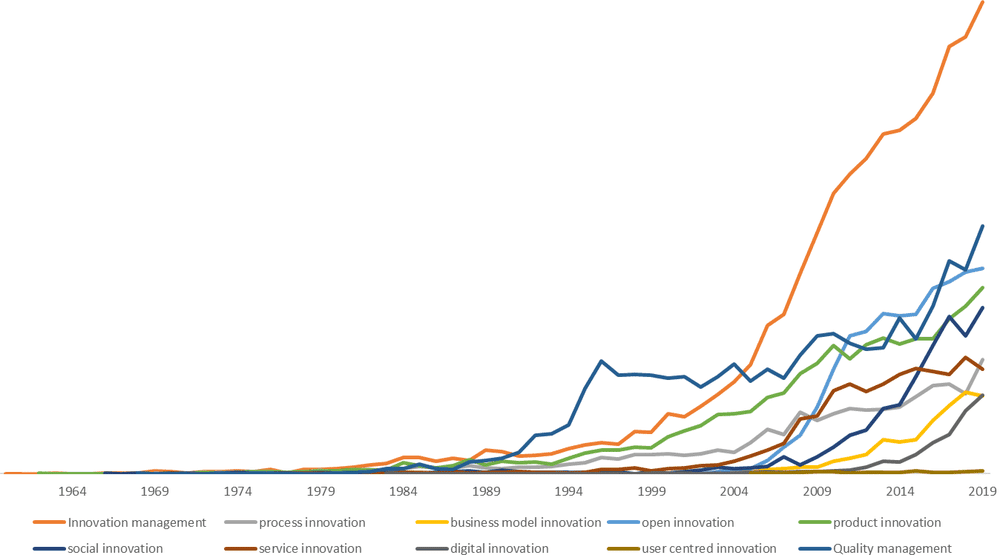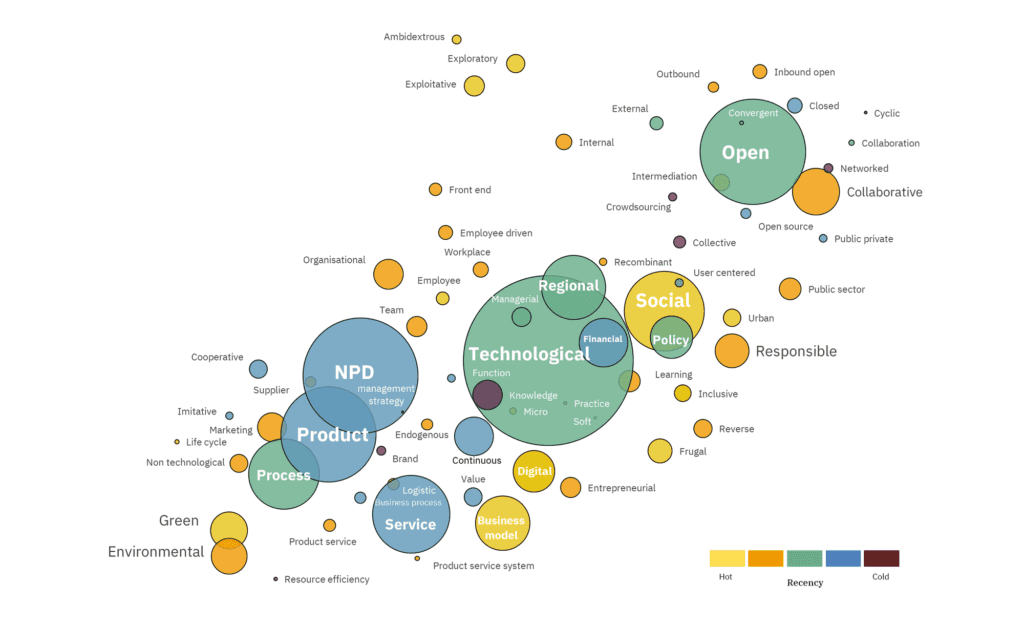Innovation is complex! In this series of blog posts Creax brings clarity by offering unbiased insights from over 54,000 research papers on #Innovation. We guide you through innovation trends and give insights how companies deal with this tricky tast. Discover the results, download the high-res #infographics and follow us.
Innovation is certainly not the easiest of processes in an organization. Different types of innovation have been tried and studied. Over the past decades, the do’s and don’ts of innovation management have been scrutinized in academic research. This resulted in a few tens of thousands of papers and a wide variety of types of innovation.
To shed light on all this, Creax brings a consolidated analysis of these insights, mixed with our expertise as practitioners in a series of articles on contemporary and challenging aspects of innovation management. This is the first in a series of two-monthly blogs about innovation management: Bringing Clarification in the Complexity of Innovation.
Innovation has evolved strongly over the years: it has transformed from a rather ad hoc incremental, company-internal matter (adjusting products, processes, services, and technology) into a cross-organizational and cross-industry/market practice.
As an expert in technological innovation and working with our customers for more than 20 years, Creax has witnessed and observed this from a very close distance. And yes, innovation has become so versatile and complex that organizations have no choice but to have a well-conceived innovation strategy and culture tied to it. Ideally, these are supported by external, in-depth expertise.
But what does this mean? And how does it impact you as an innovation director, R&D manager, or CEO of your company? Creax commits to helping you to bring lucidity to the landscape of innovation management.
Innovation, but also the methodologies and the requirements to manage innovation effectively and boost the success rate have been discussed intensively in academic literature over the years. The research of this vast amount of papers, therefore, gives a unique view of the dynamics and trends in this landscape.
To date, more than 54,000 academic papers address the broad topic of ‘innovation’, while the more specific topic of ‘innovation management’ accounted for 15,000 papers.

While innovation has been a regular topic of academic papers since the 1940s, it really took off at the turn of the century. It becomes clear that innovation management was pretty much an uncharted territory 2 decades ago.
The growing strategic relevance of innovation has also caused a shift in many companies’ priorities. Whereas in the 1980s the focus was mainly on project management and in the 1990s on quality management (the blue curve that peaks around the ’80s), the importance of innovation management has only grown exponentially since the turn of the century. Much more than quality – which became merely a primary benchmark – innovation has become the differentiator for organizations nowadays.
A huge amount of papers is behind these numbers and it is impossible to read all of them. That is why Creax has unleashed its in-house AI platform for context analysis Mynd, to discover unbiased and quantified insights on the content.
In essence, Mynd distills a hierarchical topic map from the context of large textual datasets. Creax heavily relies on Mynd for its core activities to discover technologies, applications, materials, needs, etc., and to quantify trends and correlations therein.
Moreover, the unsupervised nature of the topicing algorithm allows the exploration of unknown domains without prior knowledge, leading the researchers to those strategic insights, no matter how emerging they are.
The first result of this study is a coherent and enlightening cluster map of the “types of innovation”, as discovered by Mynd. Each bubble in this map represents a type of innovation.
Whereas the horizontal and the vertical axis have no meaning, the placement of the bubbles shows the related activity, recency, and correlation.
As such, new emerging types of innovation appear mostly as small yellow-orange bubbles. Well-established ones are shown in large green-blue circles. Smaller blue-purple types of innovation represent old themes that have been abandoned in the past. Either because they are well mastered or dead tracks.

Although most of us can easily think of a handful of types of innovations, academics distinguish between at least 70 different types of innovation. Innovation is about much more than just developing a new product or service.
Innovation is a multifaceted discipline, with numerous aspects and specialties that often interact or overlap with each other. It has to do with ideation, technology, people, organization, customer onboarding, strategy, transformation, and many more.
As you can tell from its size and central position, &technological innovation still appears to be the cornerstone of innovation. Indeed, most innovations do have a technological component to them.
Technological innovation is closely tied to traditional types such as product, service, and process innovation. Around these core types, related areas like marketing, brand, supplier, and logistics innovation orbit. Recently, the focus has shifted to contemporary themes like green, business model, and digital innovation in relation to these classic categories.
This should come as no surprise given the global shift towards eco-friendliness and the rather disruptive shake-up by digital business models like Uber, Airbnb, Amazon, etc. Another example would be the extensive digitalization in the business process (e.g. farm 4.0, drug discovery,…). In general, this supercluster refers to which aspect of your business you’re innovating.
A cluster of people-centered innovation types connects traditional product, process, and service innovation with technology. This group focuses on the roles, methods, and governance of innovation. While still emerging, the importance of people and organizational aspects in innovation is growing, highlighted by the rise of terms such as team, people, organizational, and workplace innovation. These concepts primarily concern corporate culture and organization. Additionally, a newer aspect of innovation management includes external groups, with social and responsible innovation being the predominant types.
The right corner of the cluster map groups open innovation and its different variations and derivatives to set up systematic and large-scale innovation ecosystems. The large bubble size indicates that quite some ink has already gone to the subject. But the green recency metric also shows that open innovation, as such, is no longer the hottest topic. Moreover, the fact that it takes such an isolated position in the landscape coincides with our experience that open innovation has not been widely implemented – so far.
The last cluster worth mentioning, are the emerging themes of ambidextrous, exploitative, and explorative innovation (top). These hot themes relate to the strategic aspect of innovation and will be the subject of our next post.
On one hand, this landscape shows that you can approach innovation from many angles (about 70 as we speak). As a matter of fact, the growing maturity of modern companies in the discipline of innovation exercises stipulates that applying a multi-angle approach is primordial to remain competitive and differentiating.
On the other hand, the various types of innovation in essence coalesce with the core competencies of different departments. Open innovation rather belongs to the knowledge management department, technological innovation to R&D, process innovation to engineering, while business model innovation relates more to finance.
Successful and effective innovation thus urges the capability of corporations to tear down internal silos and facilitate a cross-organizational approach to innovation. Last but not least, given the complexity of the topic, external, specialized innovation expertise is needed more than ever.
We are eager to meet the challenge of unveiling the complexity of innovation. In the next in-depth articles, we will share with you the insights on innovation types and trends, using the above cluster map as a vehicle.
We hope that these concrete findings and recommendations will guide you in the concrete management of innovation in your organization.
We want to involve you and as such build an interactive innovation community.
Let us know and we will address that in a future article. Feedback on published articles is more than welcome. It will only better illustrate how much innovation is alive today.
Building on two decades of experience with over 1,250 projects in a wide range of industries. Creax is a trustworthy innovation partner.
Building on two decades of experience with over 1,250 projects in a wide range of industries, Creax is a proven innovation expert.